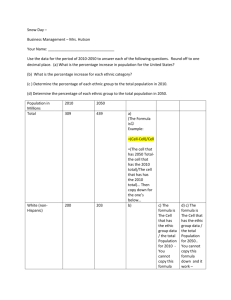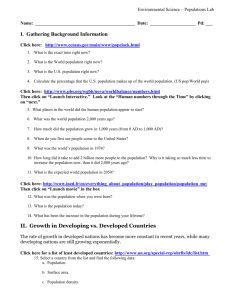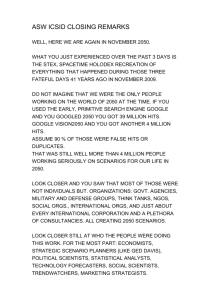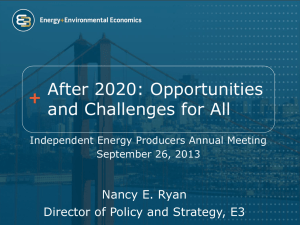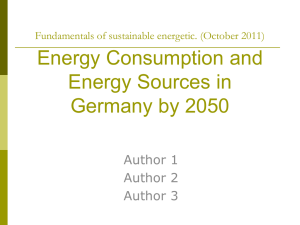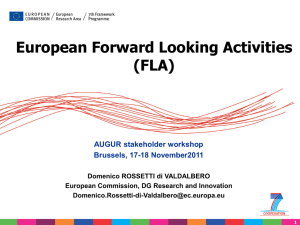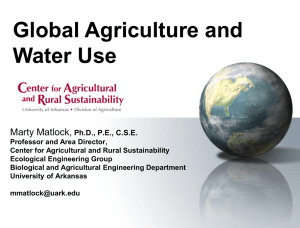Infrastructure Investment Plan for London
advertisement
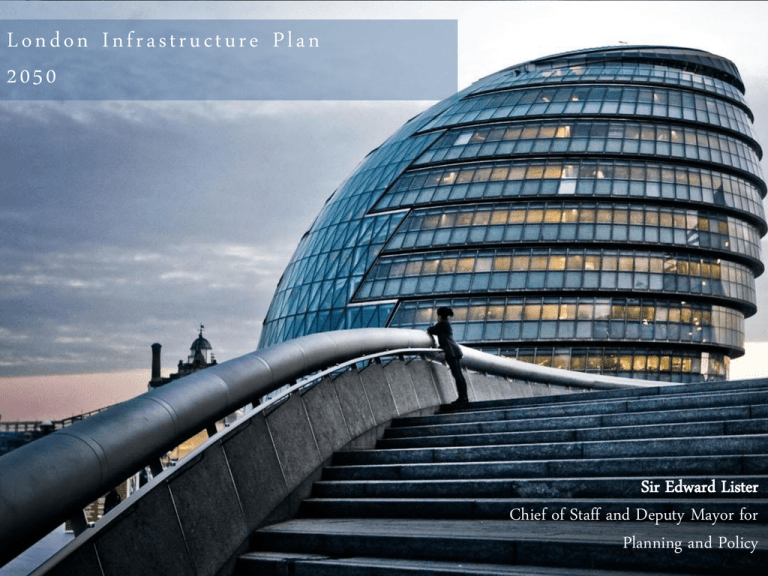
London Infrastructure Plan 2050 Sir Edward Lister Chief of Staff and Deputy Mayor for Planning and Policy WHY A LONG TERM INFRASTRUCTURE PLAN: population growth POPULATION (MILLIONS} 14 High 13.4 million 1a 12 Central 11.3 million 10 Low 9.5 million g g 'l 8 5 4 a 1900 1920 1940 1980 1990 11100 1Q20 1040 11160 tQBO 2000 2020 2040 2080 WHY A LONG TERM INFRASTRUCTURE PLAN : Announce to the world that London is the best place to do business With a million more people in London in the next decade, by 2031 we will need: • • • • 34,900 1.3m 1.3m 40,000 more homes: likely to be higher 2.2m sq ft of office space in central London alone 2.2 m sq ft of comparison retail space more hotel bedrooms WHY A LONG TERM INFRASTRUCTURE PLAN: significant economic opportunity but ferocious competition London’s infrastructure is a competitive risk Aviation Connectivity Congestion Housing Space for walking and cycling WHAT DOES LONDON NEED? INFRASTRUCTURE PLAN AIMS “Present recommendations and actions to ensure London’s infrastructure requirements to 2050 are articulated, costed and funding arrangements are in place (as far as possible). Demonstrate to the Government, Londoners and investors that infrastructure is a key priority and that London has a clear plan to meet the demands of its growing population and remain a leading world city. Ensure the London Infrastructure Plan is supported and deliverable, through active involvement of key stakeholders. Provide the Mayor and other London leaders with the information to understand and critically appraise London’s infrastructure delivery” FOUR CRITICAL QUESTIONS O V E RALL KEY FINDINGS T RAN S PO R T ( 1 ) Tube investment £15-18 bn Enable 36 trains per hour across the Jubilee, Piccadilly, Northern and Central line Transform national commuter rail network through joint investment with Network Rail (£15-20 bn) Crowding levels on the tube network 2031 Bakerloo line extension Further ‘Crossrails’ starting with Crossrail 2 by 2030 and increasing frequency of Crossrail 1 trains (£23-30 bn) T RAN S PO R T ( 2 ) A series of new river crossings in east London to overcome the major barrier effect constraining the potential of this region (£1-2bn) A comprehensive network of high quality cycle and pedestrian routes (£2-4bn) A new inner orbital tooled tunnel and series of mini-tunnels and decking over to help transform places across the city (£1525bn) A congestionbusting programme to support network functioning for essential journeys (£2-5bn) GREEN THE ALL LONDON GREEN GRID FRAMEWORK PLAN · · • Siiateg-c corridOfs Slrateg c inlls Metropc l:m park opportunlttea -?" Regiona 1 park opporluntties Regional parks e e Metropolitan !)3t ks Dtstricl parks loc;al parks &. open spactts Other/pnvate spaces ·---· Strateg c W3 king routes Strateg c cyclmg routes Sautee . Gre•1:er l.Dndon Authan1J' DIGITAL CONNECTIVITY Before 2020s…and beyond Fibre and wireless access to the internet To enable new ideas ENERGY More investment in locally produced energy (£300million in the pipeline) WATER Sewage Expected a deficit in water supply of over half a billion litres a day by 2050 Flood defence About 16% of London is built on the protected flood plains of our rivers that holds critical infrastructure. More investment is needed in flood defences that can cope with climate changes and aging existing infrastructure defences. WASTE: create facilities to re-use and recycle NEXT STEPS SPATIAL SCENARIOS Assuming current policies continue Increasing densities in locations with good public access. Increasing densities at town centres. Accommodating population outside London BETTER DELIVERY • Innovation and growth to be at the centre of our work • A new Infrastructure Delivery Group • Work to gain cross party support and commitment to London’s infrastructure projects • Reforms to the regulatory systems (energy, water and ICT) to enable delivery ahead of demand, innovation and transparency • Fiscal devolution COSTS ES TIMATE BILLIONS % OFGVA 250 tOI!E. 200 Our best cost estimates to meet all our infrastructure needs would almost double expenditure as a proportion of the economy. Housing and transport make up three quarters of the total costs 150 OVERALL CAPITAL EXPENDITURE Population 2050 of 11.3 mJIIion, construction cost inllation of 211E>per annum above RPI, pobcy aspmltions are acnieved tOO 50 211b tllb 0 Ollb 2011- 15 2016-20 2021 - 2.5 2026 - 30 2031 -35 2036 - 40 2041 - 45 2046 - 50 • • - Transport Housing Energy Water • •• Capex as qa of GVA Sll'urae: Amp Schools Waste Digital conneclivity Green infrasuucurre PAY I N G FOR IT Such a level of investment cannot be sustained doing things in the traditiona l way. INCOME FROM CENTRAL GOVERNMENT GRANTS W e need a combination of better coordination and integration, better asset utilisation, more use of data and private capital. More spending powers for London will be key. lon d on : 66'1b New York: 30.9% Tokyo: 7.7'1b FIS CAL DEVOLUTION UPLIFT IN PROPERT Y VALUES ADDITIONAL REVENUES BETTER USE OF OUR DATA BETTER INTEGRATION AND COORDINATION PROCUR EMENT PRIVATE CAPITAL YOUR INPUT KEY CONSULTATION QUESTIONS: 1. 2. 3. 4. 5. 6. 7. 8. Do you agree we should have a long term plan? Our stated requirements - any unnecessary? Anything else? Funding – how can we close the gap? What more in addition to the Delivery Board to ensure best practice, joined up delivery? Where w ill London’s growth best be accommodated? Amend incentives for utility providers to share costs more equitably? How to do this? Approach to technological change? Which innovations? How to change behaviours to reduce demand? And various sector specific questions



